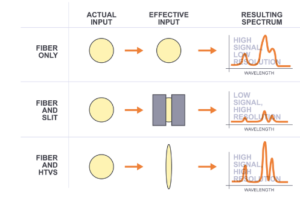Advancements on optical technology are creating many new opportunities for the use of non-destructive, real-time detection and quantification of molecular species in industries such as chemical manufacturing, oil and gas refining, bioprocessing, and pharmaceuticals. One of the fastest growing techniques for performing these process analysis measurements is Raman spectroscopy, which provides users with more accurate and more specific in situ measurements of complex chemical matrices than other real-time measurement modalities. Tornado’s HTVS™ advantage gives you a competitive edge in today’s bioprocessing marketplace.
Until recently, however, the extension of Raman spectroscopy to a wider range of applications has been limited by a long-standing trade-off in traditional spectrometer design. Using conventional Raman spectrometers, this compromise prevents any single device from achieving both the high spectral resolution and the high signal level required to differentiate chemical species under many real-world conditions. Users have been forced to choose between sensitivity (being able to detect and quantify low concentrations of a component of a chemical mixture) and specificity (being able to differentiate similar components of a mixture).
This blog describes the fundamental concepts behind the proprietary HyperFlux optical spectrometer designs developed by Tornado using their core technology – the High Throughput Virtual Slit, or HTVS™ – that eliminates the sensitivity vs. specificity trade-off inherent in other Raman spectrometers, thereby providing users with unprecedented insight into the chemistry of their manufacturing process.
Optical Spectroscopy
Spectroscopy is the analysis of the different frequency or wavelength components (colors) of light reflected, transmitted, or emitted by a material sample. With a modest amount of chemistry and physics knowledge, spectroscopic measurements can be interpreted to deduce physical and chemical properties of the material samples. Variations in molecular composition result in different optical responses, creating unique spectroscopic “signatures” which can be used to identify the materials under interrogation and determine their proportions. The devices used to measure the intensity of each wavelength of light in these signatures are called optical spectrometers, of which there are many types, depending on the specific type of spectroscopy that is being employed for an application (e.g. atomic absorption, atomic emission, LIBS, transmission, reflection, Raman, or others). This blog focuses on the use of dispersive spectrometers since their speed and absence of moving parts make them the preferred choice over interferometric or scanning filter-based spectrometers for most process Raman applications that require low cost, high speed, and high sensitivity.
Raman spectroscopy is based on an effect wherein a small fraction of the laser light striking a material will scatter (reflect) while undergoing a shift in wavelength from the original laser wavelength, while the rest of the light is scattered with no change in wavelength. This “Raman effect” or “Raman shift” creates a different distribution of scattered wavelengths for different molecules, which provides much of the power of the Raman method, as multiple chemical constituents of a mixture or matrix can be detected and quantified independently and simultaneously. However, the usefulness of Raman spectroscopy has been limited by the faintness of the Raman-shifted signal. For most molecular species, only a tiny fraction (typically 1 out of 106 to 1 out of 109) of the laser photons are Raman shifted by the sample, so the chemical measurements are based on a relatively small number of photons. Compounding the “photon-starved” nature of the Raman method, conventional spectrometers are inherently inefficient due to their narrow input apertures.
Optical Dispersive Spectrometer Parameters and The Classic Trade-Off Between Resolution and Throughput
Three of the most fundamental parameters describing an optical spectrometer’s performance are its optical spectral range or bandpass (the range of detectable wavelengths), its spectral resolution (its ability to distinguish two closely-spaced wavelengths), and its optical throughput (the percentage of light entering the device which reaches the detector). For most spectroscopic applications, all three of these parameters are all important. For example, higher spectral resolution can give a sharper view of the target spectrum, permitting a more detailed analysis. Higher throughput can provide a stronger measurable signal, improving the quality of the data. However, nearly all spectrometer designs available today include trade-offs among these critical parameters.
The generally accepted technique to achieve higher resolution in a dispersive spectrometer is to use a physical slit to mask the image of the incoming beam before it passes through the dispersive element, which effectively narrows the position of each wavelength component of the projected spectrum on the detector plane. This is a simple and effective way of improving the spectral resolution, as shown in Figure 1 below, but it comes at the high cost of wasting all of the light not passing through the slit.

Figure 1: The comparison among HTVS™, slit, and no slit
This wasted light can often constitute 80-95% of all the light entering the spectrometer (depending on the desired resolution). Unfortunately, this trade-off between resolution and throughput is not simple to overcome. Due to the conservation principle of “étendue” in an optical system, an improvement cannot be gained by using additional focusing optics to create a sharper image, as any increased focusing to increase throughput at the slit will be countered by a greater divergence of the light bream after the slit, canceling out any anticipated advantage.
Dispersive spectrometer designers have accepted the losses due to a slit and focused their efforts to improve spectrometers by optimizing the efficiency of the remaining optical elements, using more sophisticated detectors and electronics (e.g., deep-depletion CCDs or low-noise sCMOS sensors), higher-efficiency dispersive elements (e.g., volume-phase holographic gratings) and better reflective coatings (e.g., stacked dielectric coatings with <2% reflection losses). In fact, many spectrometer manufacturers quote their relative throughput by ignoring the slit loss because it is considered to be a “constant” inherent to all spectrometer designs. The full potential of optical spectrometers, however, is only achievable by solving this full order-of-magnitude loss caused by the slit, as is achieved with the development of the HTVS™ and its incorporation into all of Tornado’s Raman analyzers.
The HTVS™ and Tornado’s Spectrometer Technology
HTVS™ technology works by modifying the shape of the beam inside the spectrometer. HTVS™-enabled spectrometers use a comparatively large input aperture (for maximum signal throughput) in combination with specially configured mirrors and lenses within the device. These optical components act to reformat the collimated light beam and expand it along the dispersion axis, with the result of narrowing the refocused image of the input aperture. The resulting “virtual slit” image is narrow like a slit image, but taller (thus conserving optical étendue), and over 95% of the incoming photons are transmitted to the spectrometer grating. As a result, the HTVS™ spectrometer provides both high throughput and high spectral resolution without significant compromise.
Beam reformatting is not a new concept in spectroscopy. As early as 1938, astronomical spectroscopists conceived and implemented “image slicers” which used specialized optics to chop the circular image of a star into narrow strips and rearrange the strips into a slit-like image. Although useful in large telescope-based spectrometers, the implementation of such designs has not proven commercially practical because of the difficulty of achieving and maintaining the alignment tolerances required. Instead, Tornado’s spectrometers incorporate a novel approach where the reformatting takes place in the unfocused “pupil” or “Fourier” space rather than in image space. This proprietary approach provides a simpler and more practical implementation to reformat the beam.
While the HTVS™ technology can benefit any form of high resolution optical spectroscopy, it has demonstrated the greatest impact in dramatically enhancing the performance of Raman spectroscopy systems. Most Raman spectra consist of many sharp peaks, often closely spaced together so that high spectral resolution is required to distinguish the peaks of different chemical components from each other. But as mentioned earlier, the Raman effect is exceedingly weak, so the optical throughput efficiency of a Raman spectrometer must be as high as possible to detect enough photons to make a valid measurement of the intensity of each peak, which permits measurement of chemical concentrations. With HTVS™ simultaneously delivering high spectral resolution and maximum throughput, the quality of the resulting Raman spectra are vastly improved, and users can achieve both specificity and sensitivity in their process measurements. This performance advantage of Tornado’s Raman solutions over conventional slit-based analyzers has been demonstrated time and again in a multitude of application areas, as detailed in our white papers and webinars (available upon request).
Summary
HTVS™ technology allows the best process Raman measurements currently achievable anywhere. Combined with their small size and low cost, Tornado’s non-destructive, real-time measurement solutions offer numerous benefits for established analytical practice and facilitate broader adoption of Raman methods for pharmaceutical, petrochemical, food, biotech, and other applications.
For more information about our chemical analysis and measurement solutions, please contact us at [email protected]



